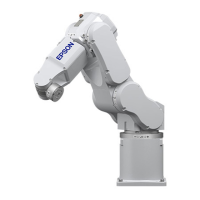Setup & Operation 4. End Effectors
S5 Rev.5 49
When calculating the critical location of the load on the Arm #5 using the allowable
moment and allowable moment of inertia, the calculated value represents a distance from
the Arm #5 rotation center, not the distance from the flange. Therefore, to get a value of
the critical location of the load on Arm #5, subtract 80 (mm) from the calculated distance
from the Arm #5 rotation center as shown the example below.
Example: Calculate the critical location of the load on the Arm #5 (c) when a 5 kg load is
on the Arm #6 rotation center line (b = 0).
Allowable Moment of the Arm #5 (N·m) / Load (kg)
= Distance from the Arm #5 rotation center (m)
12 (N·m) / 9.8 / 5 (kg) = 0.2448 → 0.295 (round down) (m) = 244 (mm)
c (mm) = Distance from the Arm #5 rotation center (mm) − 80 (mm)
c = 244 (mm) − 80 (mm) = 164 (mm)
Moment
A moment is a necessary torque (holding torque) to counteract the gravity affecting the
load.
Design an end effector so that the eccentric quantity at the position where the load is
attached is within the allowable moment.
A maximum torque (T) is calculated by the following formula.
× L (m) × g (m/s
2
)
L: Eccentric quantity of load (m)
: Gravitational acceleration (m/s
2
)
Maximum eccentric quantities of load for S5 series Manipulators are shown in the
following table.
Max. Eccentric Quantity of Load for S5 series Manipulators
Axis
Max. Eccentric Quantity of Load (mm)
(Distance between the joint rotation center and the load’s center of gravity)

